Natural disasters can upend lives, leaving homes uninhabitable and forcing vulnerable residents into temporary living situations. It is in these challenging moments that understanding your insurance coverage becomes crucial. Homeowners and renters alike benefit from a specific provision in their insurance policies designed to assist during such catastrophic events—loss of use coverage. This article will delve into the essentials of this coverage, how it operates, and what claims process policyholders should be aware of.
Recent estimates demonstrate the staggering financial implications that hurricanes and other natural disasters impose on homeowners. For instance, Hurricane Helene’s insured damages have been pegged at approximately $17.5 billion, while the more devastating Hurricane Milton may result in insured losses ranging between $30 billion and $60 billion. Such figures paint a sobering picture of the havoc wreaked upon residential properties, significantly affecting local economies and individual families. As homeowners navigate the aftermath, the importance of comprehensive insurance coverage becomes all the more apparent.
What is Loss of Use Coverage?
Loss of use coverage, often included in homeowners insurance policies, is designed specifically to cater to scenarios where a dwelling becomes uninhabitable due to a covered peril, such as a hurricane, fire, or a burst pipe. Experts indicate that this coverage typically amounts to around 20% of the dwelling coverage, intended to alleviate living expenses until necessary repairs or rebuilding can take place. For example, if a homeowner has a dwelling coverage of $100,000, they may expect approximately $20,000 in loss of use benefits. This provision can cover a range of costs, including temporary housing—be it a hotel or a rental—as well as essential living expenses like food and pet accommodations.
Moreover, renters insurance commonly includes a similar loss of use provision, with coverage proportionate to the personal property amount insured. Understanding the details of your policy ensures that you can effectively utilize loss of use coverage when needed.
When disaster strikes, it’s vital to understand how to efficiently commence a claim for loss of use coverage. Experts recommend contacting your insurance company promptly to inquire about this specific provision and how quickly it can be activated. Communication is key; insurance providers may have expedited processes available to facilitate quicker access to funds.
Moreover, it is beneficial to be well-informed about the potential covered expenses. While the fundamental aim of loss of use coverage is to support policyholders during their temporary displacement, understanding any policy limitations—such as dollar caps on specific expenses or time restrictions for filing claims—can prevent unpleasant surprises.
The Transience of Financial Relief
Although loss of use coverage serves as a lifeline for those displaced by natural disasters, experts caution that it is intended solely as a temporary solution. Jeremy Porter, head of climate implications research at First Street Foundation, emphasizes that this coverage is “generally not intended to be a long-term solution.” The reality is stark: the financial resources available under this coverage may fall short when recovering from a disaster takes longer than anticipated.
The complexity of such recovery is exacerbated by the post-disaster housing landscape. Availability tends to plummet, leading to inflated rental and hotel prices due to the overwhelming demand for temporary accommodations. This reality can create a financial strain for families attempting to navigate both immediate and long-term recovery strategies.
In addition to your insurance policy, it is essential to consider additional assistance available through agencies like the Federal Emergency Management Agency (FEMA). Policyholders should not view insurance claims as the sole source of support. Engaging both your insurance provider and governmental resources can create a more robust recovery strategy after a disaster.
Understanding the components and limitations of loss of use coverage is crucial for homeowners and renters facing the aftermath of a natural disaster. As you navigate the claims process and seek support, remaining informed and proactive can significantly impact your family’s recovery journey, providing the necessary resources to bridge the gap until normalcy is restored.


Leave a Reply